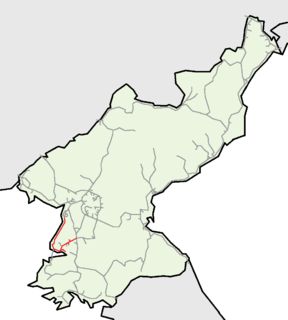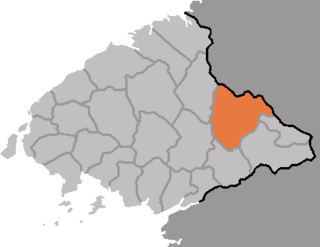
Iksan is a city and major railway junction in North Jeolla Province, South Korea.

The Gyeongui Line is a railway line between Seoul and Dorasan Station in Paju. Korail operates the Seoul Metropolitan Subway service between Seoul Station and Munsan Station.

Sinŭiju ; Sinŭiju-si, known before 1925 in English as Yeng Byen City) is a city in North Korea which faces Dandong, China across the international border of the Yalu River. It is the capital of North P'yŏngan province. Part of the city is included in the Sinŭiju Special Administrative Region, which was established in 2002 to experiment with introducing a market economy.

The Padma is a major river in Bangladesh and India. It is the main distributary of the Ganges, flowing generally southeast for 120 kilometres (75 mi) to its confluence with the Meghna River near the Bay of Bengal. The city of Rajshahi is situated on the banks of the river. However, over 256 square miles of land, as large as Chicago, has been lost due to erosion of Padma since 1966.

Dorasan Station is a railway station situated on the Gyeongui Line, which used to connect North Korea and South Korea and has since been restored. Dorasan Station is located approximately 650 meters from the southern boundary of the Korean Demilitarized Zone and is currently the northern terminus of Korail's Gyeongui Line, which is served by Tonggeun commuter trains. North of here the former Gyeongui Line continues as the Korean State Railway's P'yŏngbu Line, but this connection is not in regular service. The current purpose of the station is largely symbolic of the hope for eventual Korean reunification.

The P'yŏngŭi Line is an electrified main trunk line of the Korean State Railway of North Korea, running from P'yŏngyang to Sinŭiju on the border with China. It is the main corridor for overland traffic between North Korea and China, and is one of the country's most important rail lines. A bridge over the Yalu River connects Sinŭiju to the Chinese city of Dandong and the Shendan Line of the China Railway to Shenyang and Chinese points beyond.

Varanasi Junction, popularly known as Varanasi Cantt Railway Station is the main railway station which serves the city of Varanasi. It is also the headquarter of Varanasi railway division of North Eastern Railway zone.
Sŏp'o Station is a railway station in Sŏp'o-dong, Hyongjesan-guyŏk, P'yŏngyang, North Korea. It is on located on the P'yŏngra and P'yŏngŭi lines of the Korean State Railway.
Kalli Station is a railway station in Hyongjesan-guyŏk, P'yŏngyang, North Korea. It is on located on the P'yŏngra and P'yŏngŭi lines of the Korean State Railway.
Ch'ŏngch'ŏn'gang Station (Chosŏn'gŭl: 청천강역) is a signal halt in Maengha-ri, Pakch'ŏn County, North P'yŏngan Province, North Korea. It is on located on the P'yŏngŭi Line of the Korean State Railway, and is the starting point of the Kubongsan Line. It is situated on the bank of the Ch'ŏngch'ŏn River, from which it gets its name.

The Korean State Railway is the operating arm of the Ministry of Railways of the Democratic People's Republic of Korea and has its headquarters at P'yŏngyang. The current Minister of Railways is Jang Hyuk, who has held the position since 2015.

The P'yŏngnam Line is an electrified standard-gauge trunk line of the Korean State Railway in North Korea, linking P'yŏngyang with the port city of Namp'o and the hot springs at P'yŏngnam Onch'ŏn. The length of the line is 89.9 km (55.9 mi).
Rajin Station is a railway station in Rajin-guyŏk, Rasŏn Special City, North Korea. It is the junction point and terminus of both the Hambuk and P'yŏngra lines of the Korean State Railway. It is also the starting point of a freight-only branchline to Rajin Port Station.
Ŭnsan Station is a railway station in Ŭnsan-ŭp, Ŭnsan county, South P'yŏngan province, North Korea. It is the junction point of the Korean State Railway's P'yŏngra and Ŭnsan lines. It is also the starting point of the P'yŏngra line's Changsŏn'gang Line.

Malda Town is a railway station, serves Malda city in Malda district in the Indian state of West Bengal. It is the rail head for a visit to Gour and Pandua or notable place Adina Mosque and Adina Deer Park.
Sŏp'yŏngyang Station is a railway station in Sŏsŏng-guyŏk, P'yŏngyang, North Korea. It is on located on the P'yŏngra and P'yŏngŭi lines of the Korean State Railway.
The Changsŏn'gang Line is a non-electrified standard-gauge freight-only secondary line of the Korean State Railway in South P'yŏngan Province, North Korea, running from Ŭnsan on the P'yŏngra Line to Changsŏn'gang.
The Kubongsan Line is an electrified standard-gauge secondary line of the Korean State Railway in South P'yŏngan Province, North Korea, running from Ch'ŏngch'ŏn'gang on the P'yŏngŭi Line to East Namhŭng.
The Pun'gang Line, also called the Nyŏngbyŏn Line, is a non-electrified railway line of the Korean State Railway in Nyŏngbyŏn County, North P'yŏngan Province, North Korea, running from P'arwŏn on the Ch'ŏngnyŏn P'arwŏn Line to Pun'gang. This line serves the Nyŏngbyŏn Nuclear Scientific Research Centre, located just south of Pun'gang Station.
The Mikashi-class (ミカシ) locomotives were a group of steam tender locomotives of the Chosen Government Railway (Sentetsu) with 2-8-2 wheel arrangement. The "Mika" name came from the American naming system for steam locomotives, under which locomotives with 2-8-2 wheel arrangement were called "Mikado" in honour of the Emperor of Japan, as the first 2-8-2 locomotives in the world were built for Japan.












